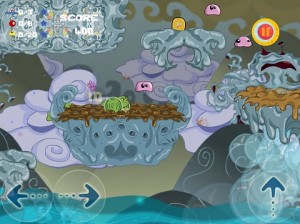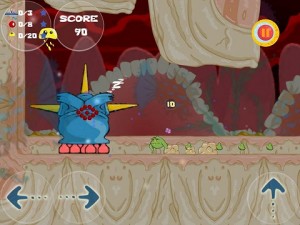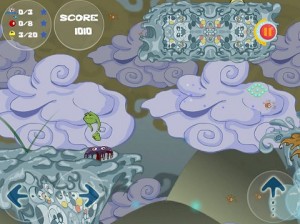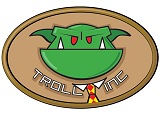 We may never know what a “jellyflug” is exactly, but we’re excited to learn more about Troll inc’s upcoming action-adventure debut. Here to talk about it is studio lead Jim Murray.
We may never know what a “jellyflug” is exactly, but we’re excited to learn more about Troll inc’s upcoming action-adventure debut. Here to talk about it is studio lead Jim Murray.
Let’s start out by learning a little about Troll inc. How many people are on the team, how do you divide all the responsibilities of game design among yourselves, and is Jellyflug everyone’s first videogame industry experience?
Troll inc was set up by Jim Murray (me), Mark Quinn, Gavin McLaughlin and Delia Millan. It’s our first commercial game for the whole team.
In terms of roles, I take care of the game design, project management, level design and business development. Mark is our Art Director and he takes care of the art styles, character designs and animations. Delia is our Environment Director and she develops all the level environments as well as the user interfaces. Gavin is our programmer and takes care of all the framework and feature programming. A more recent member, Darragh Lydon, worked on the Level Programming, UI Programming and Sound Programming and is currently working on our next big project. Finally, we had really great work from Chris Norby, who did the music, and Alan Monaghan, who did the sound effects.
Delia was completely new to the area, as she was more traditional media-based. I, Mark and Gavin have all been in Dare to be Digital, which is a contest based in Scotland where you develop game prototypes to showcase to thousands of people. That helped us get experience and our courses at the University of Ulster helped in that regard too, but other than that, yeah, we’ve been learning as we go.
 When you founded the studio, did you know for sure you’d be creating Jellyflug as your first project, or were you kicking around a number of ideas at the time? If so, do you think you’ll revisit any of those down the road after Jellyflug releases?
When you founded the studio, did you know for sure you’d be creating Jellyflug as your first project, or were you kicking around a number of ideas at the time? If so, do you think you’ll revisit any of those down the road after Jellyflug releases?
Yeah, when we founded we were weighing up a few different ideas. Some of those were a bit unreasonable for the small size of our studio, but Jellyflug was the idea everyone was drawn to. Mark, our Art Director, had already done concept work on it for his Master’s Degree and it was by far the most fleshed-out and unique idea we had. We’ll definitely be looking at some of those concepts at a later stage, and if not the games themselves, then we’ll certainly borrow ideas from those unused games for our new ones.
The thing that really strikes me in the preview footage is that Jellyflug’s interface is visually very simple but you’ve got a lot going on in the game. What are some of the player character’s abilities, and how does the player make them all work?
The user interface went through several iterations until we eventually settled on the simplest control system we could make. You can use the onscreen buttons to move your character, Grash, and anywhere you touch the screen he will fire his little baby bacteria.
 In terms of abilities Grash has all the usual controls of a platformer as far as running, jumping, etc. But where it becomes really unique is that he can fire his little army of baby bacteria at enemies to defeat them, or simply to destroy obstacles.
In terms of abilities Grash has all the usual controls of a platformer as far as running, jumping, etc. But where it becomes really unique is that he can fire his little army of baby bacteria at enemies to defeat them, or simply to destroy obstacles.
Grash starts out with four babies each level but for every “Foozle” (health pickup) he collects he gets one more baby bacterium. So if you have full health you have an army of eight little critters you can fire. Of course, if you get hurt you’ll have one less.
Grash also has a helper character called Vani; this microbe helps you by warning you about enemy bacteria and marking checkpoints in the level. There are also loads of other features like bubble jumping, fungi hopping, bouncing platforms, rolling rocks and boss battles.
Another thing that caught my attention is the game’s very thorough microbe dictionary. Is it your intention to mix real-world factoids with information that’s pertinent to the game world? And how much research did you end up doing to get ideas for the game’s creatures and environments?
One of the things we actually wanted to do with Jellyflug was to showcase the bacterial world in a fun and unique way. So we did a lot of research into bacteria, protozoa and other microbes. We felt people would find this information interesting, especially since we based many of the character features on them. So we made a feature where you can unlock information on these little microbes as you find them throughout the level. This means players can find out about microbes in a way that gives them positive feedback for finding them. Of course, it’s the kind of thing that might not interest some people so it is simply an optional component of the game that gives the experience more depth.
In terms of research, it involved days on Wikis – which were interesting – and some very scientific sites that we pretended we understood.
 It looks like Grash will meet some helpful microbes along the way in addition to enemies. What can you tell us about these and their gameplay functions?
It looks like Grash will meet some helpful microbes along the way in addition to enemies. What can you tell us about these and their gameplay functions?
You can also find bacteria Grash will have a mutual relationship with; this is based on the fact that many bacteria do in fact work together for mutual gain. We keep the controls the same throughout so the player doesn’t need to relearn them.
We have around 10 mutual microbes, all with different functions. When Grash finds a Spirillum he will gain the ability to jump over massive ravines; when he finds Streptococcus (the bacteria that cause plaque in your teeth) he can use them to eat barriers in your way, and there are loads more bacteria you can work with in a similar way.


